كهف هوق
Hoq Cave
Useful Information


| Location: |
Northeast side of Socotra Island, about 5 km from the coast.
Parking at Siqirah, RR01.
2 km, 350 m elevation gain, 1-hour walk to the cave entrance.
(12.587631, 54.354481) |
| Open: |
after appointment. [2025] |
| Fee: |
yes. [2025] |
| Classification: |
 Karst Cave Karst Cave
|
| Light: | headlamps provided. |
| Dimension: | A=350 m asl, L=3,000 m, T=26 °C, H=95 %. |
| Guided tours: | L=2,500 m, D=2 h. |
| Photography: | allowed |
| Accessibility: | no |
| Bibliography: |
Peter de Geest (ed) (2006):
Soqotra Karst Project (Yemen) 2000-2004,
Berliner Höhlenkundliche Berichte, Volume 20, pp 21 & 66.
 online
online
Julian Jansen van Rensburg (2018): Rock Art of Soqotra, Yemen: A Forgotten Heritage Revisited, Arts 2018, 7(4), 99. online DOI Ingo Strauch (2016): Indian inscriptions from Cave Hoq at Socotra, In: Boussac M.-F., Salles J-F., Yon J.-B. (eds.) Ports of the Ancient Indian Ocean, Primus Books, 79-97. academia.edu |
| Address: | |
| As far as we know this information was accurate when it was published (see years in brackets), but may have changed since then. Please check rates and details directly with the companies in question if you need more recent info. |
|
History
| 1999 | UNDP-GEF expedition. |
| 2000 | surveyed by the Belgian Socotra Karst Project-team (SKP). |
Description
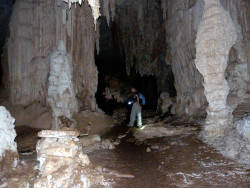
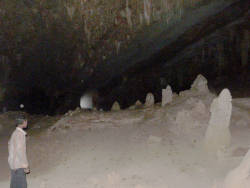
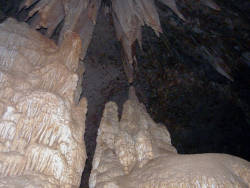
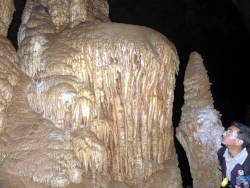
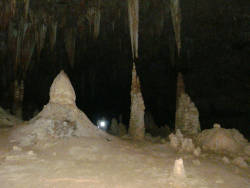
كهف هوق (Hoq Cave) is a sort of semi-wild show cave. Explored by the Belgian Soqotra Karst Project, it became famous among cavers, scientists, and tourists. To protect the cave, the Belgian cavers laid a path through 2,500 m of the cave. They also trained local villagers to guide visitors. The idea was to protect the cave by offering the locals a living and teach them about the dangers. So they are aware how to protect the cave, and they are motivated because they want to protect their business.
There have been various expeditions during the last decade to this cave. Most of them concentrated on the content of the cave, like archaeological remains, troglobionts or climatological research with speleothems. There were the Belgian caving expeditions, which concentrated on the speleological aspects. The cave contains numerous inscriptions and drawings left by ancient visitors from India, Africa, and the Middle East. Most inscriptions are written in Indian languages, 193 of 216. This reflects that Indian traders and sailors frequented the island long ago.
The cave has a huge main passage running WNW-ESE, with a mean width of 50 m and a mean height of 20 m. Two side galleries are oriented WSW-ENE. The huge passages are full of speleothems. There are stalagmites of all sizes, between some centimeters and several meters in diameter. There are helictites and rimstone pools. Hoq Cave is one of the most ancient metropolitan cave sites of the Middle East. The archaeological remains are impressive. There are also numerous endemic troglobionts living in the cave. Hoq Cave is the type locality of several invertebrates, among them the Whip Scorpions.
Tours start at the village Siqirah, which is located near the coast and easy to reach on RR01 coastal road. From here a trail leads uphill to the cave entrance, it’s a hike of about 2 km, but an elevation gain of 350 m to the cave entrance, it takes about an hour. The hillside is full of strange trees, for example, frankincense trees. The cave has a huge entrance portal in a vertical cliff and is easy to see from some distance. So this is a show cave which has a sort of trail but no light. After the entrance a light is required, we strongly recommend bringing a good headlamp. And of course it’s helpful to wear good hiking shoes. Bring sun protection and a hat, enough water and a little food for the hike. 1 h up, 2 h inside the cave, and probably a 30 min hike down makes this a 3.5 h tour.
The cave is not gated, so it is possible to visit without a guide, but we strongly recommend to go with a guide. He might point out a few things you might have missed otherwise. Unfortunately we were not able to find any contact data for the tours. We got the impression that those things are handled by local tour operators, they offer full-day trips which include the transport and the cave tour, probably also some time at the beach and more. The best way to book such a tour might be to ask at the reception at your hotel.
But one aspect about this cave is extraordinarily weird. It is listed with ISCA, the Ignorant Show Caves Association, although it is actually not a show cave, it’s a semi-wild cave. They were not able to add actual details to their listing, no contact data, no open hours, no description, there is only the name and the coordinates. And the name is misspelled, and the coordinates are wrong. In other words, there is no information at all. This is nonsense on a level that baffles us, we bow our heads in awe.
- See also
 Member of the International Show Caves Association (ISCA)
Member of the International Show Caves Association (ISCA) Search DuckDuckGo for "Hoq Cave"
Search DuckDuckGo for "Hoq Cave" Google Earth Placemark
Google Earth Placemark OpenStreetMap
OpenStreetMap Hoq Cave - Wikipedia (visited: 27-FEB-2025)
Hoq Cave - Wikipedia (visited: 27-FEB-2025) HUG CAVE (visited: 27-FEB-2025)
HUG CAVE (visited: 27-FEB-2025) Hoq Cave (visited: 27-FEB-2025)
Hoq Cave (visited: 27-FEB-2025) Socotra-pped On An Island Paradise: Day 3 – Life On Mars In Hoq Cave (visited: 28-FEB-2025)
Socotra-pped On An Island Paradise: Day 3 – Life On Mars In Hoq Cave (visited: 28-FEB-2025) Exploring caves (visited: 28-FEB-2025)
Exploring caves (visited: 28-FEB-2025) Hoq Cave: Hidden Wonder of Socotra (visited: 28-FEB-2025)
Hoq Cave: Hidden Wonder of Socotra (visited: 28-FEB-2025)
 Index
Index Topics
Topics Hierarchical
Hierarchical Countries
Countries Maps
Maps